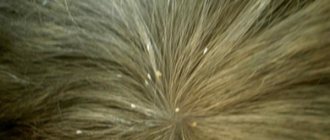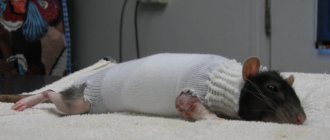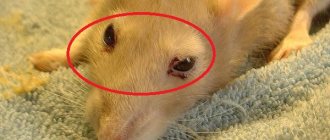Decorative rats are neat animals for which their owners provide decent living conditions.
Unfortunately, parasites are found in rats even if they are kept comfortably in an apartment, with timely cleaning and regular disinfection of the rodent cage. If your pet rat has become restless, often itches and bites fur with its teeth, scratches, bloody crusts, and areas of baldness appear on its body, then you should suspect that your furry friend has external or subcutaneous parasites. In such cases, it is advisable to immediately take the pet to a veterinary clinic to clarify the diagnosis and prescribe effective treatment, otherwise rat parasites can cause exhaustion and death of the animal.
Where do parasites come from in decorative rats?
Inexperienced rat breeders often ask a similar question when they discover parasitic animals on the body of their beloved pet. A domestic rodent can pick up parasites even with very careful care and maintenance; they can be their sources.
Filler
Often, lice eaters and ticks live in hay and sawdust, which animal owners buy in dubious places and use as filler.
Contact with infected animals
They can be domestic or wild mice and rats.
External environment
Even a loving owner who brings the infection from the street on his hands and clothes can give his pet parasites.
Gamas mite in the apartment
Predatory gamasid mites, which attack people and pets, most often end up in apartments for one of the following reasons:
- Parasites entered you on their own from the street through windows, cracks in window frames, and ventilation.
- We arrived with pet hair, shoes, clothes, and shopping.
- They crawled from the basement, attic or cavities in the structure of a building or house where birds nest, rodents, amphibians and other insects live.
In order for a gamas tick to feel comfortable in an apartment, it needs:
- Food sources - people or animals
- Darkness
- Air humidity above 50–60%
- Increased warmth
Gamasid mites do not live permanently on those they bite. In nature, attacking birds, animals, amphibians, reptiles and insects, they usually settle near or inside their burrows, nests or other shelters. In a person’s home, the insect will find a place similar to what it chooses in nature. It can be:
- Products made from down and feathers
- Products made from natural fabrics
- Houseplants
- Small and large household appliances
- Cracks, space behind peeled wallpaper
- Area under the window sill
- Interior items, especially from natural materials
Parasites are attracted to heat, movement and carbon dioxide. It is these criteria that they will be guided by both when choosing shelter and when choosing a food source. To avoid wasting time looking for food, ticks are likely to choose a place for nesting near a bed, sofa, armchair or chair where a person spends a lot of time. If there are pets in the house, this could be a bed, a scratching post, toys made of fleecy materials, bedding in a cage or a terrarium.
Major rat parasites
In decorative rats you can find different types of ectoparasites, all of which cause unbearable itching and anxiety to the animal.
lice eaters
Red wingless small insects no larger than 1 mm in size with an oblong elongated body covered with bristles, shaped like cat fleas. In light-colored rodents, adult insects can easily be detected in the fur. Rat pests feed on particles of the epidermis and blood of the rodent.
Infection of domestic rats with lice eaters is accompanied by severe debilitating itching in the rodent; the domestic rat becomes very restless, twitchy, often itches intensely, refuses to eat, and progressive exhaustion is observed. There are numerous wounds, scratches, and bruises on the pet’s body, accompanied by severe swelling and inflammatory processes.
Lice eaters in rats multiply rapidly; an adult female lays more than a hundred nit eggs, which stick to the animal’s fur. The owner can detect light shiny inclusions on the lower back and near the tail, fixed in the pet's hair and reminiscent of ordinary dandruff. It is almost impossible to remove nits from a rat's fur, only by completely removing the animal's hair. A huge number of larvae emerge from the eggs, which within a month become adult, sexually mature individuals.
The parasitism of lice eaters in rats is dangerous due to the death of the pet, so treatment should begin at the first characteristic symptoms of infection.
Lice
Lice in rats cause severe itching and anxiety; these parasitic insects feed only on the blood of a domestic rat; per day, one louse attaches itself more than 10 times to the animal’s skin. Adults can only be seen under a microscope; the body size of the parasites is no more than 0.5 mm.
Rat lice are small red insects with an elongated body, at the head end of which there are hooks for holding on the animal’s body and two sharp stilettos for piercing the skin. The louse cuts through the skin, injects substances that prevent the rodent's blood from clotting, and attaches itself to the animal's body.
Reproduction of lice occurs in the same way as in lice, with the deposition of nit eggs and the hatching of nymphs, which turn into sexually mature individuals. White shiny nits of lice can be found on the fur of a rat; parasitism is accompanied by severe nervousness of the animal, active itching, lethargy and apathy of the pet; the development of anemia, typhus and hemobartonellosis in the rat is possible.
Fleas
Rat fleas are unpleasant blood-sucking insects of a red-brown color with a characteristic body flattened on both sides, the size of the insect is 2-5 mm. The flea is capable of jumping long distances and clinging to the host's fur with tenacious claws, and is capable of migrating between cats, dogs and rats.
When infected, pets constantly scratch itchy areas, become restless, and may develop anemia. Dried burgundy crusts can be found on the animal's body - flea secretions; when bathing a rat, they turn the water pink.
Mites are very common in rats; there are several types of parasites that live on the skin and in the epidermal layer. The rat tick is red-brown in color, 0.1-1 mm in size, has an oblong flat body, feeds on the blood of an animal and carries various serious diseases. With a lack of nutrition, the tick is capable of attacking humans.
IMPORTANT!!! Rat mites are dangerous to humans! People, especially children, have a hard time with eczematous dermatitis, which develops as a result of parasitism by these insects. Ticks infect people with typhus and murine typhus, tularemia, plague, rickettsial infections and Q fever.
Subcutaneous mites live in the upper layer of the epidermis under the skin of a rodent. It is impossible to visually detect these mites; the diagnosis is made only on the basis of examination of skin scrapings under a microscope.
Parasitism of ticks on the body of a rat is manifested by characteristic symptoms: hair loss and the formation of multiple swollen red wounds on the neck, head, spine and shoulders of the rodent.
Ear mites primarily attack the delicate skin of the ear, pinna and nose, which is manifested by the appearance of yellow or red growths on the ears, nose, limbs and genitals.
Bedbugs
Ordinary bed bugs can also drink blood from decorative rats, causing severe itching, scratching, anemia, and infection with blood parasites. Bedbugs attack domestic rodents during periods of food shortage or the absence of a person nearby as a food source.
What symptoms do the bitten areas show?
Ticks love to bite most of all where a person's skin is thinnest and most delicate. If anyone is wondering where to look for such a tick on the body. Where he likes to go most of all, we can say with confidence that these bloodsuckers really like to suckle in places such as:
- under clothes that fit tightly to the body - under the belt, for example, where the collar, cuffs are, under the straps on the wrist, and so on;
- in the depressions on the body - armpits, navel, ears, etc.;
- inside folds of skin - in the groin, on the abdomen, under the mammary glands.
The symptoms of a tick attack and the appearance of the bitten areas can be represented by the following manifestations:
- There is a feeling as if someone is crawling over the body or moving in one place.
- The affected area is constantly itching.
- Redness of the skin at the site of the bite.
- A black or brown dot if the insect has attached itself to the skin.
- A red dot on the skin if the insect fell off on its own after drinking blood.
- A rash if enough time has passed after the bite for an infection reaction to occur through the blood.
- An increase in temperature already indicates infection of the body.
General symptoms persist for about two weeks, and the bite mark can still last 20 days. After this, the disease caused by the infection enters into an active phase if you do not rush to treat the bitten area in time.
Treatment of an infected rat
Specifying the type of parasite and prescribing treatment should be carried out by a specialist in a veterinary clinic, since different medications are used to destroy external and subcutaneous parasites. In case of complications, the animal is prescribed anti-inflammatory ointments, immunostimulating drugs and a course of vitamins and antibiotics.
Insecticidal preparations are highly toxic; if handled incorrectly or in excess of the dosage, there is a risk of poisoning a decorative rat. It is advisable that the animal be treated by a veterinarian; it is also permissible to treat a furry pet at home in a well-ventilated area, strictly following the recommendations of a specialist.
At the same time as treating your pet, you need to throw away the bedding, disinfect the cage and all accessories several times, change the filler, and treat the entire room with repellents. It is advisable to throw away all wooden objects from the cage; they can be places where parasites accumulate. The rodent's claws should be trimmed short during treatment to prevent scratching of the skin.
When keeping domestic rats in groups, all rats must be treated repeatedly to avoid re-infection. If a pet is bitten by fleas or bedbugs, it is recommended to treat all pets living in the house with insecticides, as well as the room itself: carpets, upholstered furniture, mattresses, floors, etc.
Prevention measures
Preventing the occurrence of rat mites primarily involves timely getting rid of rodents that carry them. Includes the following measures:
- Control over the size of the rat population and constant measures for deratization in areas inhabited by rodents.
- Isolation of premises from rats. The sealing of manholes is carried out by residents.
- Maintaining premises in proper sanitary and technical condition.
You should know that rat mites reproduce in warm conditions and in the presence of food. It can develop all year round, but is especially active in the spring. Parasites are very easy to disinfest and die almost immediately. Most often, to get rid of them, a one-time treatment of the premises is enough. However, after a while they may appear again if preventive measures are not followed. If ticks reappear, acaricide treatment is carried out again.
Sources
- https://misterklop.ru/klesshi/krysinye-i-myshinye-kleshhi-kto-eto-kak-vyglyadyat-na-chyom-parazitiruyut-mogut-li-prichinit-vred-cheloveku-sposoby-borby-v-domashnih- usloviyah
- https://likehamster.ru/domashnie-krysy/o-zdorove/parazity-u-krys-kak-borotsja/
- https://parcenter.ru/myshi-i-krysy/kleshhi-u-dekorativnyh-krys.html
- https://homkin.ru/krysy/zdorovie-krys/blohi-vlasoedy-vshi.html
- https://hlopklop.com/zhiv/krysinye.html
- https://dezplan.ru/vopros/krysinye-kleshchi-foto-ukusov-i-lechenie
- https://TezarVape.ru/ektoparazity/kleshchi-u-krys.html
- https://sichovka.ru/parazity/gamazovye-kleshchi.html
[collapse]
Ways and causes of infection
Lice eaters become more active in the autumn-winter period, when the most preferable conditions occur - long, thick hair on animals, high air humidity.
Increasing dry air and bright sunlight have a detrimental effect on parasites. In addition, lice eaters cannot remain without their owner for a long time; in this case, death occurs on the second or third day.
Infection occurs through close contact with an already sick animal, objects of common use, such as bedding, mattress, harness. Parasites are more likely to attack weakened, emaciated animals.
Consequences for animals
The animal becomes lethargic, exhaustion appears, and immunity decreases. As a result, chronic problems worsen, infectious diseases and colds become more common.
Anemia and vitamin deficiency may develop. Another danger of lice eaters is that they themselves are carriers of many diseases and can cause fungal, viral, bacterial, and helminth diseases.
In any case, infestation with parasites undermines the health of the infected animal, causing numerous problems.
If lice eaters are found in budgies, then in the absence of treatment and prevention measures, the birds may die! Very often, lemon tree owners may notice strange growths on the plant - these are scale insects. Find out how to get rid of it by reading our article.
Rat flea bites are very dangerous, as these parasites carry many diseases. What to do if you find bites of these insects, read the link https://stopvreditel.ru/parazity/perenoschiki/krysinaja-bloha.html.
Why you should contact us
- The City Disinfection Center provides a guarantee for its services and always fulfills its obligations in full.
- We answer clients' questions competently and promptly, giving them the opportunity to be aware of all stages of the work.
- We find a special approach to each customer, which allows us to reduce the cost of services.
We will help you deal with rats quickly and effectively and prevent their reoccurrence. You can find out information of interest about the work of our company or call a specialist to the site by calling the contact number in Moscow.
Our specialists
Vadim Lukoyanov
instructor-disinfector
Work experience 14 years, 6 years worked at the Center for Hygiene and Epidemiology in Moscow. Professional education, instructor-disinfector.
Sergey Polozkov
disinfectant
5 years of experience. Professional education in the field of “Disinfection”, disinfector.
Kirill Vasiliev
disinfectant
7 years of experience. Professional education in the field of “Disinfection”, disinfector.
Content
- What harm do rats do?
- Habitats of rats Black rat (ship)
- Gray rat (pasyuk)
Rats are very smart, fertile and well-adapted animals. They have an extremely developed sense of smell, which allows them to smell danger a mile away. With the help of teeth that grow throughout their lives, rats can even chew through metal. They overcome obstacles in their path up to 80 cm high, swim well, and when running they reach a speed of 10 km per hour. It is not surprising, therefore, that people have still not been able to get rid of their undesirable neighborhood.
- For apartments
- For legal entities











